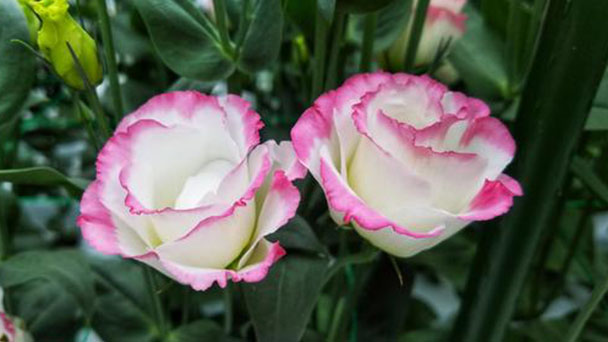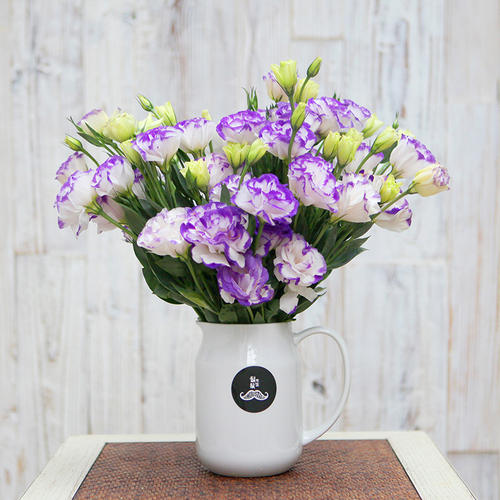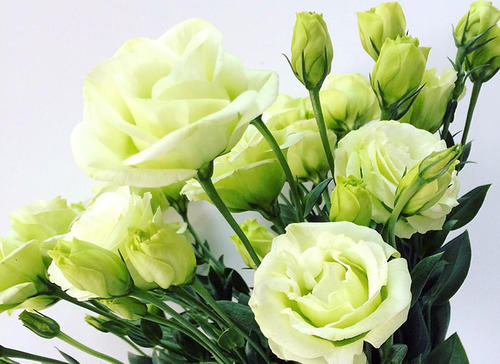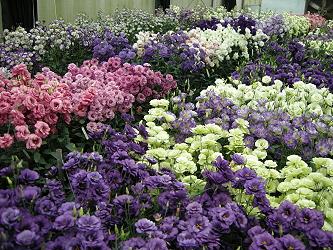Texas bluebell profile
Written by Maggie
Aug 31 2021

Texas bluebell, scientific name Eustoma russellianum, is a perennial plant of the Gentian family. It is native to the limestone zone between the southern United States and Mexico and grows 30-100 cm high. Leaves of Texas bluebell are opposite, broadly elliptic to lanceolate. Texas Bluebell is one of the most popular varieties of potted and cut flowers in the world.
Texas bluebell picture

Morphological characteristics of Texas bluebell
Strain
Texas bluebell (Eustoma russellianum) is a perennial plant in the Gentianaceae family, with plant height ranging from 30 to 100 cm.
Leaf
Texas bluebell (Eustoma russellianum) leaves opposite, broadly elliptic to lanceolate, almost sessile, base slightly operculate; Leaf surface is blue-green.
Flowers
The pistil and stamen of Texas bluebell (Eustoma russellianum) are conspicuous, the bracts are narrow and lanceolate, and the petals are imbricated. The color is rich, monochrome and polychrome, petal single and double. texas bluebell is a plant of the genus Gentian of the Gentianaceae family. Texas Bluebell is light and slow, elegant and bright, and lovely in shape.
Ecology of Texas Bluebell
Texas Bluebell (Eustoma russellianum) likes a warm and light environment. The suitable temperature for growth is 15 ~ 25℃, and it is resistant to high temperature. The requirement is loose and fertile, the calcareous soil with good drainage.
The distribution of Texas Bluebell
Texas Bluebell (Eustoma russellianum) is a native of Nebraska and Texas.
Texas bluebell growing methods
The optimum temperature for the growth of Texas Bluebell (Eustoma russellianum) was 15 ~ 28℃, and the temperature at night during the growth period was not lower than 12℃. Winter temperature is below 5℃, leaf clusters are rosette, can not blossom.It can also withstand 0℃ low temperature for a short time. When the temperature of the growing period exceeds 30℃, the flowering period is shortened obviously.
Texas Bluebell (Eustoma russellianum) is strict about water. Although Texas Bluebell likes a humid environment, excessive water is unfavorable to the root growth of Texas Bluebell, which is vulnerable to disease invasion. After bud formation, high temperature and high humidity should be avoided, otherwise it is easy to cause fungal diseases. At the same time, the growing period water supply is insufficient, the stem and leaf growth is weak, and early flowering. Therefore, drip irrigation facilities are very beneficial to the growth and development of Texas Bluebell cultivated in Israel.
Texas Bluebell (Eustoma russellianum) is sensitive to light. Long sunshine is very beneficial to the growth and development of Texas Bluebell, which is conducive to the growth of stem and leaves and the formation of flower buds. Generally, 16 hours of sunlight a day has the best effect.
Texas Bluebell requires fertile, loose and well-drained soil. Do not continue to work. Potting soil must be disinfected, can be treated with high temperature steam or methanol bromide soil, soil output with 6.5 ~ 7.0 is appropriate.

Texas bluebell propagation methods
Texas bluebell (Eustoma russellianum) propagates by sowing. texas bluebell seeds are small, with 22,000-22,500 seeds per gram, and the germination rate is 80% ~ 85%. The suitable temperature for germination is 22 ~ 24°C. Texas bluebell is a photophilic seed. After sowing, it is not covered with soil and only needs to be lightly pressed. Before sowing, the pot soil and containers should be strictly high temperature disinfection.Germinate 10 to 14 days after sowing, and thin the seedlings once 10 days after germination.
Texas bluebell (Eustoma russellianum) seedlings grow very slowly and should be carefully managed. Try not to damage the root system during thinning, and do not transplant too deep. When 4 ~ 5 true leaves, Texas bluebell (Eustoma russellianum) can be planted in 8 ~ 15 cm basin. During operation, the root should not be damaged, otherwise it is difficult for the seedlings to return to normal growth. Growing period every half a month fertilizes 1 time, or uses 15-15-30" Hui You "potted flower special fertilizer and 12-0-44 potassium nitrate fertilizer. If medium cut flower varieties are used as pot ornamental, spray the plants 2 ~ 3 times with 0.03% ~ 0.05% Bijiu solution in 20 days after planting.
To the branching strong variety can be used to pick the heart, to promote more branching, more flowering, lower plant shape. In the growth process, high temperature and long sunshine can promote flower bud differentiation, achieve the goal of early flowering and shorten the growth period. The average potted Texas bluebell (Eustoma russellianum) takes 120 to 140 days from sowing to flowering, while the cut flower variety takes 150 to 180 days from sowing to flowering.
Sowing and tissue culture were the main methods of Texas bluebell (Eustoma russellianum) propagation. Growth at the seedling stage is extremely slow. Texas Bluebell can be grown in the open or in a greenhouse. Cultivation temperature should not be lower than 15℃. Although Texas Bluebell has certain tolerance to high temperature, the temperature should be controlled below 25℃ in summer high temperature season, otherwise the quality of cut flowers will be affected, especially after the formation of flower buds, flood and high temperature must be avoided, otherwise diseases are likely to occur. Under high temperature and strong light, water demand of texas bluebells (Eustoma russellianum) increases. At this time, the substrate should be kept moist. Drought affects the elongation of flower stems.
Cultivation substrate should be added peat soil, rice bran and a small amount of lime and other improved garden soil, before planting to add barnyard manure, bone meal and so on as the base fertilizer, because of its large fertilizer amount, the growth process of timely topdressing, data show that calcium nitrate is a good fertilizer, which provides nitrogen, but also supplement calcium.
Disease Control of Texas bluebell
Stem blight and leaf spot are common hazards of Texas bluebells (Eustoma russellianum). Stalk blight was sprayed with 10% antibacterial 401 acetic acid solution 1000 times liquid. Leaf spot was treated with 50% tobujin wettable powder 500 times liquid spray for control. Insect pest has aphid, roll leaf moth harm, can use 40% diego emulsion 1500 times liquid spray kill.
The main diseases of Texas bluebell (Eustoma russellianum) are stem blight, root rot, gray spot and so on. Stem Blight is a fungal infection that mainly harms the stem of the plant. When the disease occurs, the cortical tissue of the stem of Texas bluebell rots. High temperature and humidity environments easily lead to the occurrence of the disease. At the beginning of the disease, 1% Bordeaux liquid is sprayed. In severe cases, 50% methyl tobutine WP 500 times liquid and 50% paraconin WP 500 ~ 800 times liquid can be used alternately, spraying once every 3 ~ 5 days. Also pay attention to strengthen ventilation and light; Reduce plant planting density; Reasonable application of nitrogen fertilizer, appropriate increase of phosphorus and potassium fertilizer, improve plant disease resistance.
Root rot is also a fungal disease of Texas bluebell (Eustoma russellianum). It mainly infects the Texas bluebell root and rhizome. Black necrotic spots are formed in the rhizome when the disease occurs, and plants die in severe cases. The fungus spreads mainly by soil, fertilizer, watering and so on. Prevention and control methods: use decayed fertilizer; Water is appropriate to avoid water; At the beginning of the disease can be used 50% carbendazim wettable powder 600 times liquid, every 10 days or so spray once, 2 ~ 3 times in a row.
Texas bluebell functions and uses
Texas Bluebell (Eustoma russellianum) is elegant, fresh and elegant in color. Potted plant is used at adornment bedroom, balcony or windowsill, present dense European type emotional appeal. If put into pieces hotel.Music teahouses, shop windows, bank lounges and stair corners express an atmosphere of elegance and luxury. If you cut a few purple Texas bluebells as the main flower, add white lilies and willow branches and insert them into a bamboo basket, the combination of Chinese and Western will form a picturesque and intoxicating scene.

Latest Updated
- Benefits of Bugleweed - 7 Science-backed Health Benefits
- Bugleweed Dangers & Side Effects - Is It Poisonous?
- How to Plant Evergreen Trees - What You Should Know
- When to Plant Evergreens - Grow Guide for Evergreen Trees
- 12 Wonderful Evergreen Shrubs for Your Garden
- 12 Popular Evergreen Plants with Pictures for Beginners
- When And How To Prune A Lilac Bush Like a Pro
- How to Grow & Care for Lilac Vine (Hardenbergia Violacea)
- Japanese Lilac Tree (Syringa Reticulata) Care & Propagation Guide
- Shumard Oak Pros and Cons - What to Know
Popular Articles
- Winter maintenance of Antirrhinum Majus
- How to Grow Terminalia Mantaly Tree
- How to Grow and Care for Crossostephium Chinense
- How to grow Antirrhinum Majus in spring
- Peristeria Elata (Dove Orchid) Profile: Info & Care Guide
- Underwatered Snake Plant (Sansevieria Trifasciata) - Signs And How To Fix
- How to Care for Brazilian Jasmine Plant (Mandevilla Sanderi)
- How to Grow & Care for Graptopetalum Purple Delight in Summer
- Rosa Chinensis (China Rose): Plant Growing & Care Tips
- How to Care for Baby Sun Rose (Aptenia Cordifolia)